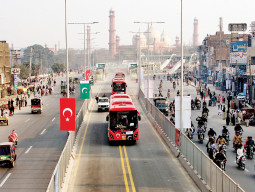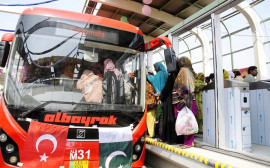
Take the Metro Bus, a Bus Rapid Transit (BRT) system recently inaugurated in Lahore. Public transport is about cities, about mobility, about infrastructure, about local politics, about so many things. How can one begin to reply to a question asking whether one is for or against the Metro Bus? The sophistication of what the BRT represents cannot be explained away through such a binary divide, though the exercise does give one an insight into the sociopolitical motivations of the person answering.
“The BRT was too expensive,” some will argue. One can try to compare the cost of similar projects elsewhere but will probably come to conclude that (1) the characteristics of the BRT system set up elsewhere were unique to its circumstances (no two cities are alike); (2) it was expensive elsewhere, too; and (3) that the Metro Bus BRT is substantially cheaper than the other transport option the Government of Punjab had: a multibillion-dollar underground/overground mass transit system.
“The BRT has hurt the built environment of the city”, others will argue, and will explain how the metal grill that protects the BRT corridor as it snakes through the city is an act of ‘severance’ — neighbourhoods, mohallas and the social infrastructure they support are now strewn apart by the BRT. When Robert Moses built Manhattan’s West Side Highway, he destroyed the dockyards that had, for centuries, been one of the great sources of income for New York City. Through these and other acts of highway “severance”, many have argued that the Moses-style development eventually led the city to bankruptcy in 1975. Could the BRT, critics will suggest, mean such a future for beautiful, historical Lahore?
“How could the Government of Punjab afford such an expensive project on one road in one city of the province”, you will be told, “when people perish every year simply because the city doesn’t have a single waste treatment plant and allows all of its industrial municipal waste to be dumped into the Ravi to pollute the surface water downstream?” The enormous chunk of the provincial annual development budget the Metro Bus consumed is subject to final determination, but all agree it was a massive chunk.
I’m a past master at criticism but am beginning to understand that in our complicated and sophisticated world — while we are all free to try and explain it in the simplest of terms — mistakes can happen. One can spend a lifetime debating the points above and a mountain more but the fact is that Lahore now has a multibillion-rupee, 28-kilometre cement, steel and Metro Bus BRT system. (One should also note the city also has a multibillion-rupee nearly-completed Ring Road as well, as this argument applies to it, too). What needs to be done looking ahead is to assess the situation and see how we can plan to try to ensure that the Metro Bus works properly and that the city benefits from it. Here, I will offer two thoughts to critics and armchair activists seeking a quick and easy explanation.
First off, we must eschew quick planning. The remarkably quick construction of the BRT can be compared with how quickly similar projects are carried out elsewhere. But you’ll be missing the point if you don’t recognise the big difference between the two: elsewhere, projects are quick in the construction because they were years in the preparation. Ours was quick in construction because it was missing some preparation.
Secondly, the demerits of poor planning should not mean we desist from planning and development altogether. The BRT is an ambitious project but its success or failure doesn’t take from the fact that transportation and mobility are two commodities in great demand everywhere in the country. We need more transport projects, but the next ones need to be better planned and better executed. (One notable exception: the team that put together the software for operating the Metro Bus needs to be commended; their effort was entirely homegrown, in record time and remarkable cost-effective). We now know what our mistakes are. Second attempts should ensure they are not repeated.
Published in The Express Tribune, April 21st, 2013.
COMMENTS (3)
Comments are moderated and generally will be posted if they are on-topic and not abusive.
For more information, please see our Comments FAQ













































"Build it " and they will come... "Maintain it" and they will expand it
Rush to implement something for the common man in election year when you're position is threatened after doing nothing for 4 years... thats vote buying!
Underpasses and flyovers that allow the car owning affluent to zoom past the riff raff is nation building. Do something for the common man, and its vote buying. Anyways, whether the BRT is successful or not needs to be seen in the long run. Maybe 5 or 10 years from now. Its impossible to come to conclusions today.